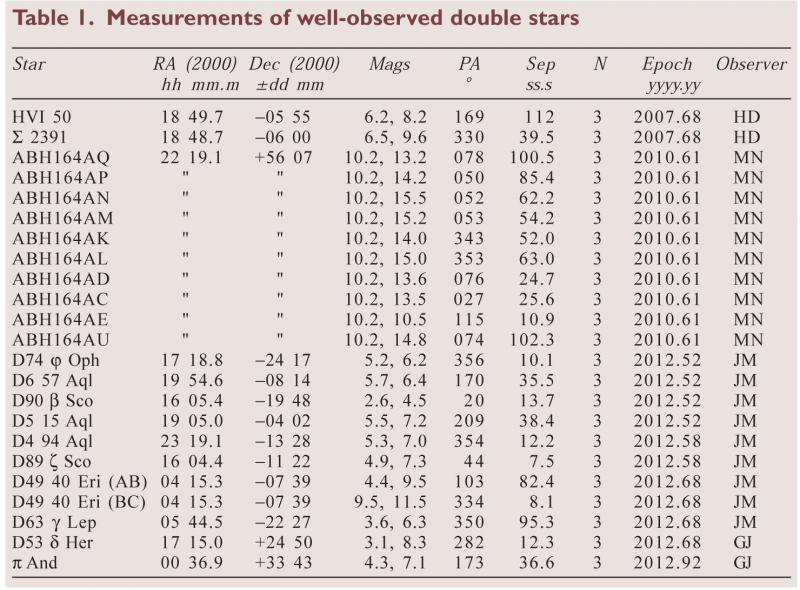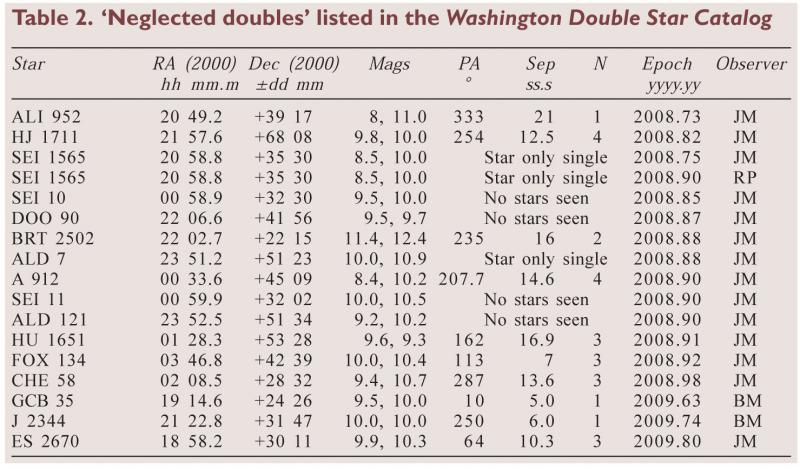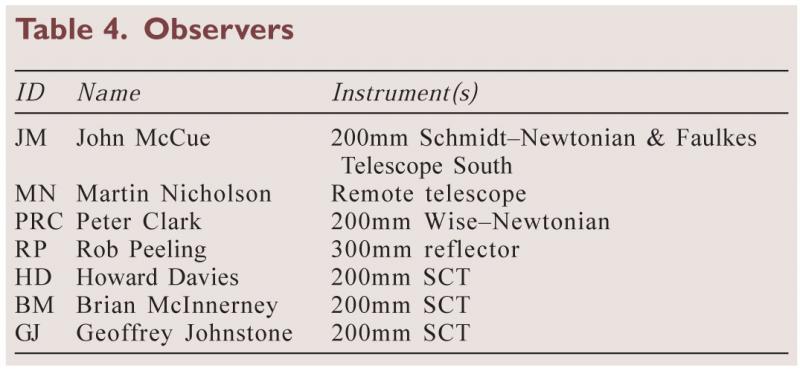2017 August 3
Measurement of double stars
This short paper reports measurements of double stars made by BAA members, and aims to encourage double star observing by briefly describing the main observational ways of carrying out these measurements.
Introduction
An accumulation of measurements for any particular binary star (a double star that is a gravitationally-bound system) enables their orbits around each other to be worked out. This is the only direct way of determining a star’s mass. Surprisingly, fewer of these orbits are known than one might imagine.
The two vital parameters that describe a double star’s configuration are its separation (in arcseconds) and the position angle of the secondary star with respect to the primary star (in degrees, measured from north through east).
Methods of measurement
This first short paper reports on visual methods.
Astrometric eyepiece
Optical manufacturers produce eyepieces with inscribed angular and linear scales that are internally illuminated and can thus be seen superimposed on the view of the double star. The scale is quite complex, but the position angle and separation can be measured quite quickly and easily with a little practice.
The double star separation is measured using the scale across the middle of the reticle, and the position angle is found by allowing the binary to drift across the reticle to reach the protractor scale around the side. Full instructions are given by the manufacturer, but many articles are also available, for example Teague, Sky and Telescope, 2000 July, p.112-114.
Crosshair method
The problem with the method described above is that an astrometric eyepiece is quite expensive. The author presents here a method which is cheap but relatively untested. You need a simple crosshair eyepiece and a stopwatch.
When you have the double star in your eyepiece, turn off the telescope drive and rotate the crosshairs until one arm is aligned with the way the stars are drifting, which is of course the E-W direction. Move the telescope (with the motor drive controls if available) until the double is ‘upstream’ of the wires, and time the difference between when the primary crosses the N-S wire and the secondary does so. In Figure 1, the primary is shown at the central wire crossing but that doesn’t have to be the case; both stars just have to cross the N-S wire. Make a note of the time on your stopwatch. This will be time B1B2.
Next, turn the crosshairs until one arm is aligned with the two stars themselves (the dotted lines in the diagram), then time the difference (again the drive should be off) between when the secondary crosses that arm (with the primary crossing the central wire crossing point) and when it crosses the other arm. Again, the primary doesn’t have to go through the centre, but if not, time the difference between when the two stars cross the ‘non-aligned’ arm, no matter whether on the top side or lower side of the middle. This will be the time B1B3.

The diagram in Figure 1 also shows the two formulae that are solved to give the values of s (separation) and Θ (position angle). Note also that you will substitute for the value of δ, the declination of the double star. When you have calculated s, you must convert the seconds of time into seconds of angle by multiplying by 15.
The diagram also gives two example times, B1B2= 3.4 seconds, and B1B3= 7.3 seconds. Try the formula – these two times should give separation s= 37.4″ and position angle Θ= 43.0°, if the declination δ is 60°.
Notice that if the position angle is more than 90° but less than 180°, the primary will still lead the way across the wires, and the same formula holds good, but the calculated p.a. will be 180°-Θ. If the p.a. is between 180° and 270°, the secondary will now lead the way; again the same method and formula can be used, and the calculated p.a. will be 180°+Θ.
Finally, if the p.a. is between 270° and 360°, the secondary will still lead the way, the same method and formula can yet again be used, but the calculated p.a. will be 360°-Θ.
If the p.a. is close to 0° or 180°, then the timing becomes very difficult.
This method is the author’s own devising and is untested by the wider community of double star observers; consequently observers are urged to try this out. Notwithstanding, it has been used on six selected double stars, and the results are shown in Figures 2 and 3, which show the accuracy of the observations (how close they are to the accepted value), and their precision (the size of the error bars). It can be seen that the method works well on the double stars’ separation, but on their position angle (acute angle) the accuracy and precision both deteriorate above about 50°. The author is working on an addition to the method to combat this defect.
BAA observers’ results
The measurements in Tables 1, 2 and 3 are taken from Binary, the newsletter of the Deep Sky Section double star group, and were made by the BAA observers in Table 4 using CCD and astrometric eyepiece methods.

N is the number of measurements made for each observation; clearly more than one measurement of a double star must be made, on any one occasion, for the purposes of reliability. Epoch refers to the actual date of observation, which need not be accurate to more than two decimal places of a year.
Table 1 gives results for well-observed doubles, i.e. those that have been regularly observed and measured by observers around the world. 

Martin Nicholson has reported that examination of the third U.S. Naval Observatory CCD Astrograph Catalogue (UCAC3, which has now been superseded by UCAC4 and can be accessed online through many links, including the Vizier site) has yielded 284 previously unobserved double stars where each component of the pair shows a large shared proper motion, indicating a genuine gravitational connection. Details of brightness, motion, position angle and separation are presented in the UCAC3 catalogue. I observed four of these, with measurements given in Table 3. I have given temporary designations in the left-hand column prior to establishment by the WDSC, with the exception of MN15, which has now been identified as an established double, SKF1249, first observed in 1896.
Suggested double star targets
The Cambridge Atlas of Double Stars by Will Tirion and James Mullaney (2009, ISBN 978-0521493437) presents a list of showpiece doubles which everyone should see. This portfolio shows the wide variety and the spectacular sights that double stars bring to the observer at the telescope. Famous examples such as the Trapezium in the Orion Nebula, the Double-Double in Lyra, Regulus, Albireo, Sirius, Mizar and Alcor, Vega, Delta Cephei, Castor and Rigel are all there. A second edition of The Cambridge Double Star Atlas is now available (2015, ISBN 978-1107534209).

Working through this list, the author realised that he hadn’t seen many of them before, and some of them, like Regulus and Rigel, are so familiar as naked-eye stars that they are often neglected by amateur telescopes, and are even overlooked as double stars. This is definitely a collection of celestial wonders to see.
Checking which were visible from the UK left 101 in the list, out of the original 133. These 101 showpiece doubles from the original list by Tirion & Mullaney from the first edition of Cambridge Atlas of Double Stars are shown in Figure 4.
If any observers would like to share their experiences of observing these gems, whether with sketches, images, descriptions or measurements, the Deep Sky Section would be pleased to share them with other observers.
——————————————————-
John McCue graduated in astronomy from St. Andrews and began teaching. He gained a Ph.D. from Teesside University studying the unusual rotation of Venus. In 1979, he and colleague, John Nichol, founded the Cleveland and Darlington Astronomical Society, which then worked in partnership with the local authority to build the Wynyard Planetarium and Observatory in Stockton-on-Tees. He is currently double star advisor for the British Astronomical Association. John has also published a short article on observing double stars.
Prior to the Double Star report being incorporated into the Deep Sky Section Newsletter, John had published three editions of “Binary”, the Journal of the Double Star Group; these can be found here:
Article originally published in the JBAA 124, 3, 2014
Readers may be interested to explore the BAA’s Deep Sky Section which is where double star observations should be submitted, or to look at observations BAA members have uploaded to the BAA Members Pages.
[Thumbnail image: Chandra X-ray image of Sirius A & B]
| The British Astronomical Association supports amateur astronomers around the UK and the rest of the world. Find out more about the BAA or join us. |
